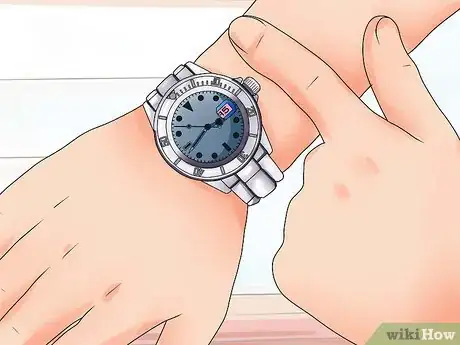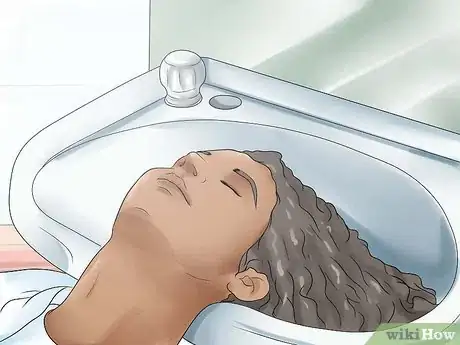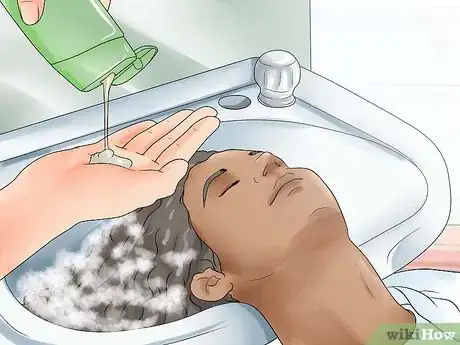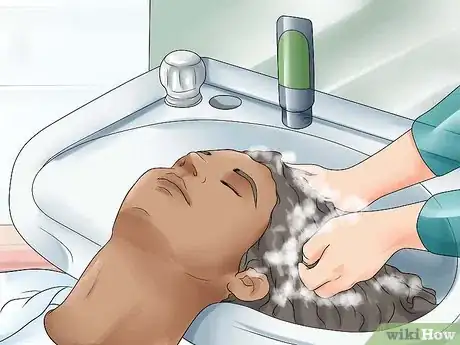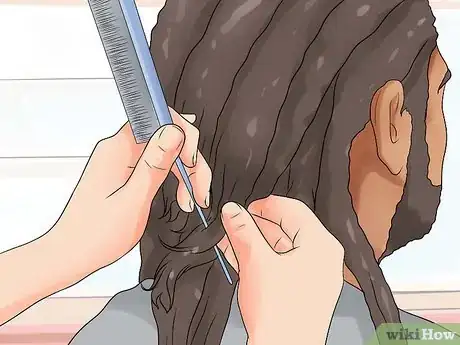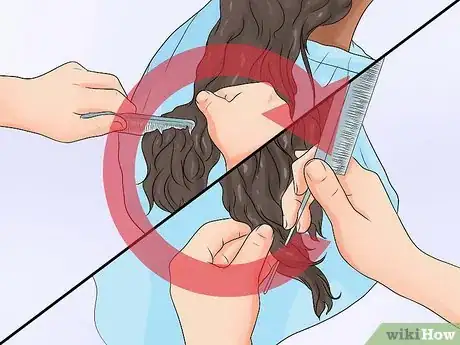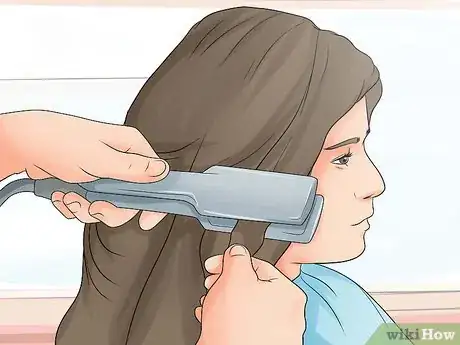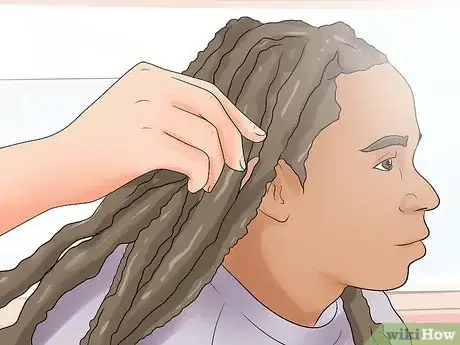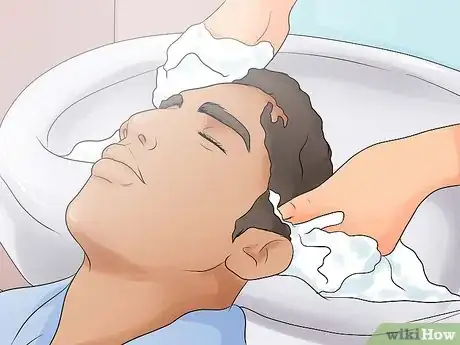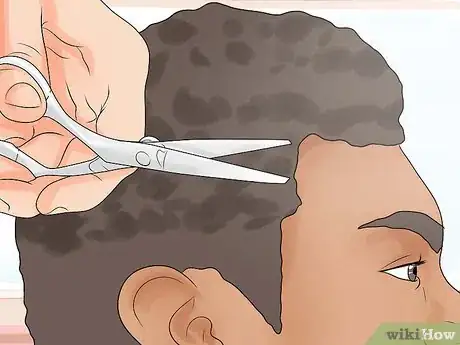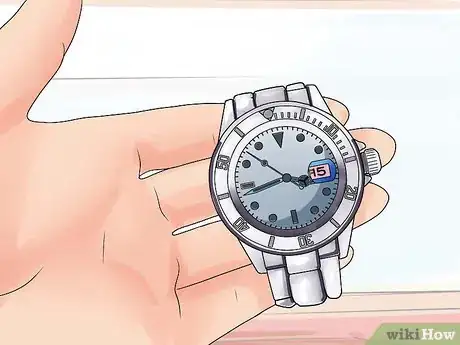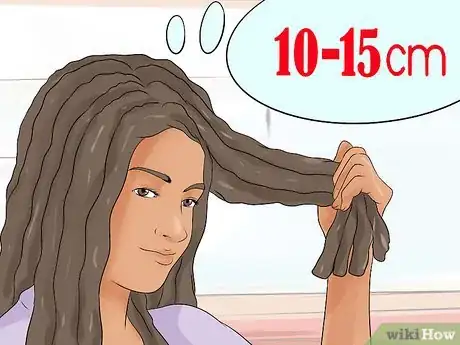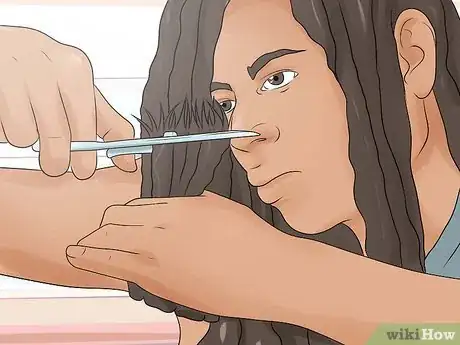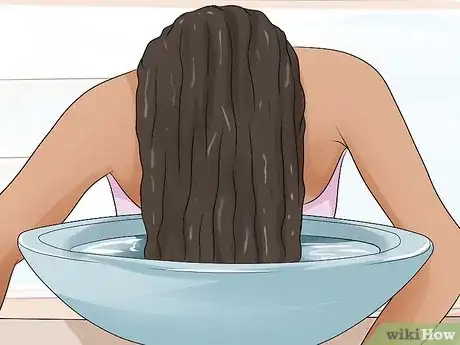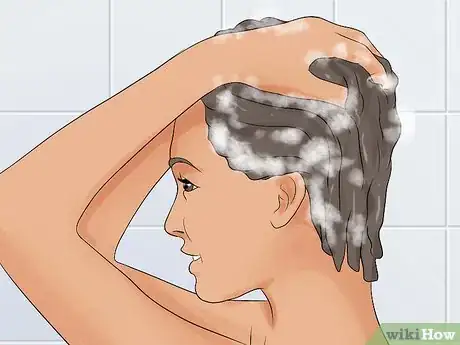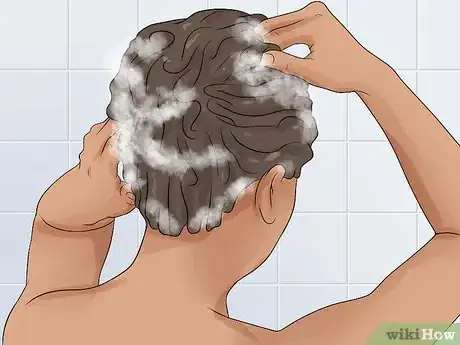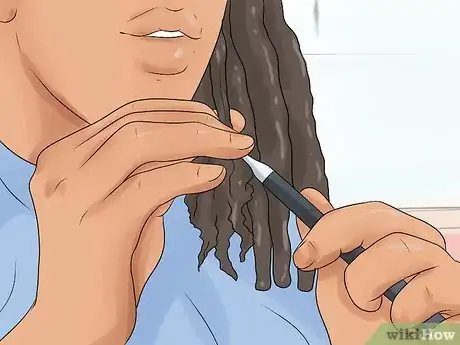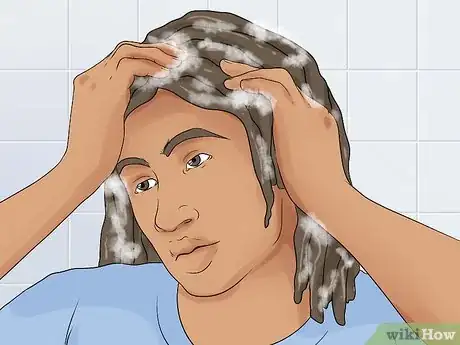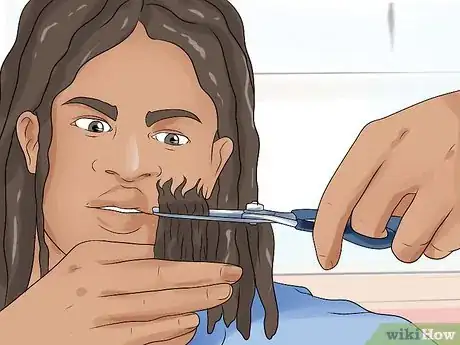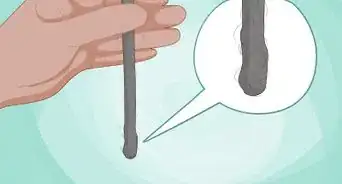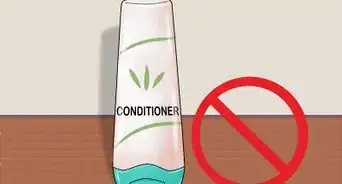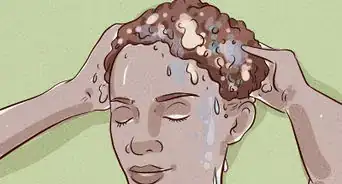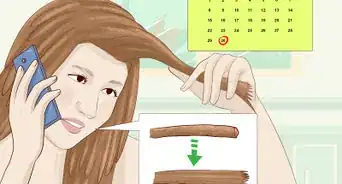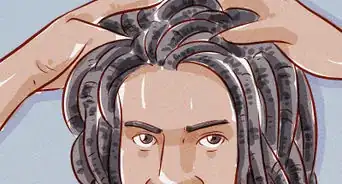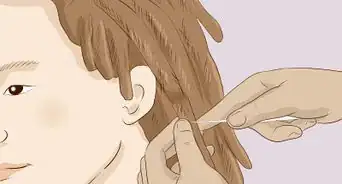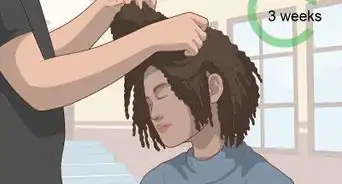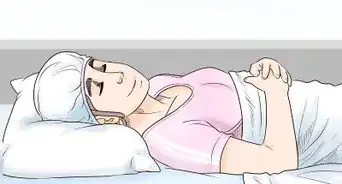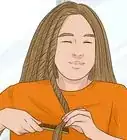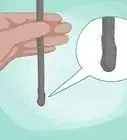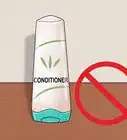This article was co-authored by Nikia Londy. Nikia Londy is a Hair Augmentation Specialist and the Founder and CEO of Intriguing Hair, a one-stop solution for women from all ethnicities wanting to purchase high-quality human hair extensions, hairpieces, and wigs. With over 16 years of experience, she specializes in artificial hair integrations, hair extensions, hair loss, hairpieces and wigs, and non-surgical hair replacement. Nikia holds a BA in Organizational Leadership from Charter Oak State College and received her Cosmetology Certification from Blaine Beauty School. She is also a member of the American Hair Loss Council.
This article has been viewed 73,870 times.
It's commonly believed that you can only undo locks by cutting or shaving them off, but you can actually unlock and unravel them without losing much length. The process is time-consuming and can be a little painful, though.
Steps
Method One: Unraveling Locks
-
1Set aside plenty of time. You can “unlock” your dreadlocks without cutting them, but the process will take a long time. Short locks that have only been around for a year or less might come undone within four to eight hours. Longer locks that you've had for multiple years may take 15 to 48 hours.[1]
-
2Address any large problems. Before removing individual locks and small knots, look for any locks that have joined together and any large matted sections at the root. Gently pull these areas apart using your hands.
- Work as close to the scalp as possible while doing this.
- If you cannot remove these tangles without severely breaking your hair, it's best to wait until you work on the smaller locks before removing these large knots.
Advertisement -
3Soak your locks for 10 minutes. Fill a sink or basin with warm water and lean back, submerging your locks completely. Let your locks soak for a full 10 minutes.
-
4Wash the locks with shampoo. Work small amounts of detangling or degreasing shampoo into each section of each lock. Wash each lock with hot water, as well.
- The water should be as hot as you can make it without burning yourself.
- The hot water and shampoo should help melt any wax and grease that has built up.
- Thoroughly rinse the shampoo out of your locks before continuing.
-
5Work conditioner into each lock. Apply small amounts of conditioner to each section of each lock. Rub the conditioner into each lock using your fingers.
- Do not rinse the conditioner out of your locks at this point.
- If necessary, you can wrap your hair in a towel to keep it out of your face until you are ready to continue.
-
6Gently pick apart one lock from the bottom. Use a metal comb to pierce the bottom of the lock and work apart the knots there. Gradually work your way up the entire length of the lock in the same manner.[2]
- A tail comb is easiest to use. You can use the tip of the tail to pierce the bottom of your lock.
- If you're using a regular comb, you will need to work the teeth of the comb into the bottom of the lock.
- After inserting the comb into the lock, gently pull it apart using the comb and your fingers. Don't be afraid to apply a significant amount of pressure.
- If the locks are too tough to unravel, work more conditioner and warm water into the hair before trying again.
-
7Comb out the loosened portion periodically. After you pull apart 1 inch (2.5 cm) or so, comb through the top of the loosened section down to the very bottom.
- Repeat this step for every 1 inch (2.5 cm) you unravel.
- Removing the tangles and shed hair throughout the unraveling process will lead to fewer problems than waiting until the very end.
-
8Repeat with the remaining locks. After you unravel one lock, repeat the same process with the remaining locks. Work on each lock one by one until all of them have come undone.
- If you have difficulty working the locks apart with a comb, you might find it easier to do so with a metal knitting needle or long sewing needle. When using a needle, slip the point into a loop near the edge of the dread and carefully pull the loop out. Repeat as needed along the length of the lock.
- This can take a long time to do, but it's totally worth it if you've been wanting to switch up your hairstyle for awhile.
-
9Condition your hair. Apply more conditioner to your hair after unlocking it all. Let the conditioner sit on your hair for five minutes before rinsing it out.
- This round of conditioner should help repair some of the damage caused by the picking process.
-
10Care for your hair well. Your hair will probably look unhealthy immediately after the removal of your locks, but if you wash and condition it regularly, its condition should improve quickly.
- Use a leave-in conditioner each time you wash your hair for the first week or so.
- When drying your hair, use a low temperature setting.
- Straighten your hair with a flat iron to manage any waves or frizz.
Method Two: Cutting Locks
-
1Examine the locks. The hair closest to your scalp will not be locked yet, so you will need to identify areas of new growth that are still loose.[3]
- Most of this new, loose growth can be saved when using this method.
- Note that older locks tend to be solid closer to the scalp than newer locks.
- Also note that this process is the quickest way to remove your locks and will usually take an hour or less.
-
2Cut the dreads near the root. Cut the locks off one at a time with sharp barber scissors, snipping just above the solid portion of each lock.
- You will likely have between 1 and 2 inches (2.5 and 5 cm) of hair left on your scalp.
-
3Wash thoroughly. Once you no longer have any solid dreadlock to deal with, wash your remaining hair well with warm water and shampoo. Rinse well to remove any residue.
- Apply conditioner to the hair, as well. A deep conditioner can repair damage and make the detangling process more successful.
- Washing and conditioning your hair now will make it easier to brush and even it out later, so it is strongly recommended that you do this step before you do any further tidying.
- Do not dry your hair at this point. Do so only after your hair has been brushed and trimmed.
-
4Brush it out. Use a sturdy metal comb to brush out the remaining hair on your scalp, making it as straight as possible.
- Don't expect your hair to be completely smooth. Frizz is normal, but you need to brush out as many knots and tangles as possible.
-
5Tidy it up. The remaining hair on your scalp will probably look uneven initially, so you may need to even it out with scissors or clippers.
- The easiest thing to do is to shave the scalp clean with clippers, but doing so is not strictly necessary.
Method Three: Combination Technique
-
1Set aside enough time. This method does not require quite as much time as a full unraveling, but it will be more time-consuming than cutting your locks out.
- Depending on how many locks you have, how old the locks are, and how much of your hair you intend to keep, this process could take anywhere from 2 to 15 hours.
-
2Determine how long to leave the hair. The exact length is yours to decide, but typically, you should plan on saving at least 4 to 6 inches (10 to 15 cm) to make this method worth the time.
- This method works best if you want to keep some of your hair but have locks older than four years. When you've had locks for more than four years, it is best to cut off half of your hair or more before trying to unlock the rest.[4]
-
3Cut the dreads at an even position. Use barber scissors to cut each dread one at a time, keeping roughly the same amount of each one intact.
-
4Soak the remaining locks. Fill a bucket or sink with warm water. Sit in front of the water and tip your head back, submerging as many of your locks as possible.
- For best results, try to soak your locks for 5 to 10 minutes. Any amount of soaking time is better than none, though.
-
5Wash well. Work detangling shampoo into your locks, scrubbing it in thoroughly using your fingers. Use hot water during this process, as well.
- The water should be hot, but not hot enough to burn your scalp or fingers.
- Washing your hair should help remove some of the build-up that would otherwise interfere with the unlocking process.
- Rinse the shampoo out of your locks before continuing.
-
6Condition the remaining locks. Rub a little conditioner or specialized lock removal product into each lock, working with them one by one.
- Do not rinse the conditioner out of your hair after applying it.
-
7Pick out each lock one by one. Pierce the bottom of the lock with the tail or teeth of a metal comb. Use the comb to pick out loops and tangles within each lock.
- Start at the bottom and gradually work your way up the rest of the lock.
- Comb out the loosened hair after every 1 inch (2.5 cm) or so.
- Repeat this process on each dread, working one at a time, until all the locks have been undone.
-
8Condition once more. After undoing your locks, apply conditioner to your hair again.
- Let it sit for a few minutes before rinsing it out with warm water.
- The extra conditioner you apply now should help repair damage to your hair.
-
9Trim uneven ends. Brush out the loosened hair and carefully trim the ends to balance out the entire style.
- Note that it might be easiest to do this while your hair is still wet. Dry your hair after tidying it up, not before.
-
10Care for your hair. Your hair may seem frizzy and unhealthy at first, but if you wash it regularly and apply conditioner after each wash, it should become notably healthier within a week or two.
Community Q&A
-
QuestionWhich shampoo must I use?
 Community AnswerI recommend Pantene because it smoothes and nourishes hair, and is helpful for hair growth.
Community AnswerI recommend Pantene because it smoothes and nourishes hair, and is helpful for hair growth.
Warnings
- Expect to lose a lot of hair, regardless of which method you use. Most of the hair you will lose during the unraveling methods has already been naturally shed and was merely caught in the tangled lock until now, however.⧼thumbs_response⧽
Things You'll Need
Unraveling Locks
- Metal comb
- Shampoo
- Conditioner or lock removal product
- Spray bottle
- Rubber gloves
- Towels
Cutting Locks
- Barber scissors
- Metal comb
- Hair clippers
- Shampoo
Combination Technique
- Barber scissors
- Metal comb
- Shampoo
- Conditioner or lock removal product
- Spray bottle
- Rubber gloves
- Towels
